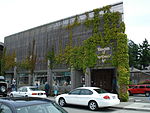Bethsaida Swedish Evangelical Lutheran Church Parsonage
Buildings and structures in Skagit County, WashingtonLutheran churches in Washington (state)National Register of Historic Places in Skagit County, WashingtonProperties of religious function on the National Register of Historic Places in Washington (state)Residential buildings on the National Register of Historic Places in Washington (state) ... and 6 more
Swedish-American culture in Washington (state)Swedish-American historyVictorian architecture in Washington (state)Washington (state) Registered Historic Place stubsWashington (state) building and structure stubsWestern United States church stubs

Bethsaida Swedish Evangelical Lutheran Church Parsonage is a historic church parsonage in La Conner, Washington. Bethsaida Swedish Evangelical Lutheran Church was built in 1890. The parsonage building which was located next to the church, was built in Vernacular Late Victorian style. The parsonage was added to the National Register in 1990.
Excerpt from the Wikipedia article Bethsaida Swedish Evangelical Lutheran Church Parsonage (License: CC BY-SA 3.0, Authors, Images).Bethsaida Swedish Evangelical Lutheran Church Parsonage
Best Road,
Geographical coordinates (GPS) Address Nearby Places Show on map
Geographical coordinates (GPS)
| Latitude | Longitude |
|---|---|
| N 48.391388888889 ° | E -122.44222222222 ° |
Address
Best Road
Best Road
Washington, United States
Open on Google Maps







